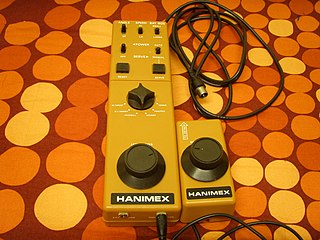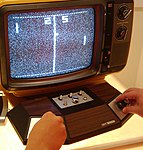
Pong is a table tennis–themed twitch arcade sports video game, featuring simple two-dimensional graphics, manufactured by Atari and originally released on 29 November 1972. It was one of the earliest arcade video games; it was created by Allan Alcorn as a training exercise assigned to him by Atari co-founder Nolan Bushnell, but Bushnell and Atari co-founder Ted Dabney were surprised by the quality of Alcorn's work and decided to manufacture the game. Bushnell based the game's concept on an electronic ping-pong game included in the Magnavox Odyssey, the first home video game console. In response, Magnavox later sued Atari for patent infringement.

A video game console is an electronic device that outputs a video signal or image to display a video game that can be played with a game controller. These may be home consoles, which are generally placed in a permanent location connected to a television or other display devices and controlled with a separate game controller, or handheld consoles, which include their own display unit and controller functions built into the unit and which can be played anywhere. Hybrid consoles combine elements of both home and handheld consoles.

The Magnavox Odyssey is the first commercial home video game console. The hardware was designed by a small team led by Ralph H. Baer at Sanders Associates, while Magnavox completed development and released it in the United States in September 1972 and overseas the following year. The Odyssey consists of a white, black, and brown box that connects to a television set, and two rectangular controllers attached by wires. It is capable of displaying three square dots and one line of varying height on the screen in monochrome black and white, with differing behavior for the dots depending on the game played. Players place plastic overlays on the screen to display additional visual elements for each game, and one or two players for each game control their dots with the knobs and buttons on the controller by the rules given for the game. The console cannot generate audio or track scores. The Odyssey console came packaged with dice, paper money, and other board game paraphernalia to accompany the games, while a peripheral controller—the first video game light gun—was sold separately.
A multitap is a video game console peripheral that increases the number of controller ports available to the player, allowing additional controllers to be plugged in simultaneously in a manner similar to a power strip or a USB hub. A multitap often takes the form of a box with three or more controller ports which is then connected to a controller port on the console itself.
A video game accessory is a distinct piece of hardware that is required to use a video game console, or one that enriches the video game's play experience. Essentially, video game accessories are everything except the console itself, such as controllers, memory, power adapters (AC), and audio/visual cables. Most video game consoles come with the accessories required to play games out of the box : one A/V cable, one AC cable, and a controller. Memory is usually the most required accessory outside of these, as game data cannot be saved to compact discs. The companies that manufacture video game consoles also make these accessories for replacement purposes as well as improving the overall experience. There is an entire industry of companies that create accessories for consoles as well, called third-party companies. The prices are often lower than those made by the maker of the console (first-party). This is usually achieved by avoiding licensing or using cheaper materials. For the mobile systems like the PlayStation Portable and Game Boy iterations, there are many accessories to make them more usable in mobile environments, such as mobile chargers, lighting to improve visibility, and cases to both protect and help organize the collection of system peripherals to. Newer accessories include many home-made things like mod chips to bypass manufacturing protection or homemade software.

The ColecoTelstar Marksman, commonly abbreviated as Telstar Marksman, is a first-generation home video game console that featured a light gun. It was released by Coleco in 1978. Because it had a manufacturer-set number of games, it is considered a dedicated console. It was part of the Coleco Telstar series Pong-based home video game consoles; it is essentially a Coleco Telstar Colortron bundled with a "3 in 1" light gun and two shooting games. The Marksman light gun is a pistol that features an attachable stock and barrel. It is similar in this regard to the later-released Stack Light Rifle and the Sega Menacer. The elongated barrel included a simple aiming sight. In addition to the light gun, the system featured two paddle controllers built directly into the console. Its reported features included "on-screen digital scoring" and three different difficulty settings. It required two nine-volt batteries or Coleco's Perma Power AC adaptor to power the system.

The APF Microcomputer System is a second generation 8-bit cartridge-based home video game console released in October 1978 by APF Electronics Inc. with six cartridges. The console is often referred to M-1000 or MP-1000, which are the two model numbers of the console. The APF-MP1000 comes built-in with the game Rocket Patrol. The APF-MP1000 is a part of the APF Imagination Machine. The APF-MP1000 and the APF Imagination Machine were developed in part by the noted engineer Ed Smith.

The TV Scoreboard is a Pong-like dedicated home video game console manufactured in Hong Kong from 1976 through the early '80s and made by Tandy. Distribution was handled exclusively by RadioShack.
Various accessories for the PlayStation 3 video game console have been produced by Sony and third-party companies. These include controllers, audio and video input devices like microphones, video cameras, and cables for better sound and picture quality.

The AY-3-8500 "Ball & Paddle" integrated circuit was the first in a series of ICs from General Instrument designed for the consumer video game market. These chips were designed to output video to an RF modulator, which would then display the game on a domestic television set. The AY-3-8500 contained six selectable games — tennis, hockey, squash, practice, and two shooting games. The AY-3-8500 was the 625-line PAL version and the AY-3-8500-1 was the 525-line NTSC version. It was introduced in 1976, Coleco becoming the first customer having been introduced to the IC development by Ralph H. Baer. A minimum number of external components were needed to build a complete system.
GameCube accessories include first-party releases from Nintendo, and third-party devices, since the GameCube's launch in 2001.
Unisonic Products Corporation was an American manufacturer and distributor of consumer electronics from the 1970s to the 1990s. Although headquartered in New York City, Unisonic outsourced its manufacturing operations to various facilities in East Asia. Unisonic developed a variety of electronics, including calculators, CRT television sets, video game consoles, digital watches, telephones, answering machines, and digital alarm clocks.
Magnavox Odyssey is the general brand name of Magnavox's complete line of home video game consoles released from 1972 through 1978. The line includes the original Magnavox Odyssey console, the Magnavox Odyssey series of dedicated home video game consoles, and the Magnavox Odyssey 2 ROM cartridge-based video game console released in 1978. Philips Odyssey is the brand name that includes the Philips Odyssey series of dedicated home video game consoles.
Various accessories for the PlayStation 2 video game console have been produced by Sony, as well as third parties. These include controllers, audio and video input devices such as microphones and video cameras, and cables for better sound and picture quality.

The Xbox Wireless Controller is the primary game controller for the Xbox One and Xbox Series X/S home video game consoles, also the official controller for use in Windows-based PCs, and compatible with other operating systems such as macOS, Linux, iOS, and Android. The controller maintains the overall layout found in the Xbox 360 controller, but with various tweaks to its design, such as a revised shape, redesigned analog sticks, shoulder buttons, and triggers, along with new rumble motors within the triggers to allow for directional haptic feedback.

The Telescore 750 is a dedicated first-generation home video game console manufactured and released by Groupe SEB in 1977, only in France for 100 Franc. Two revisions were released afterwards; the Telescore 751 in 1978, identical to the Telescore 750 but with two detachable game controllers and support for a lightgun sold separately, and the Telescore 752 in 1979, which was almost identical to the Telescore 751 but could also display games in color and had the lightgun included.

The Turnir is a dedicated first-generation home video game console that was manufactured by the Ministry of the Electronics Industry and released in 1978 only in the Soviet Union. It was manufactured between 1978 and 1982 and is the only known Soviet video game console that uses the AY-3-8500 chipset from General Instrument. The price for the system varied from 150 Soviet rubles in 1978 to 96 rubles in the late 1980s. The console uses an integrated AC adapter with a voltage of 9 volt and has a mass of 2.5 kg.

The Wonder Wizard is a dedicated first-generation home video game console which was manufactured by Magnavox and released by General Home Products in June 1976 only in the United States.












